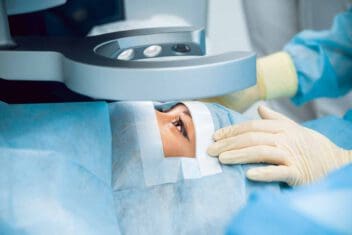
Medically Reviewed by Roberto Roizenblatt, M.D. NVISION Surgeon
What Is the Recovery Time After Detached Retina Surgery?
Home / Eye Conditions & Eye Diseases / Retinal Detachment: Causes & How to Get Treatment /
Last Updated:

Medically Reviewed by Roberto Roizenblatt, M.D. NVISION Surgeon
There are three types of surgery used to repair a detached retina. Retinal detachment surgery recovery timelines are different for each type of surgery, but the overall range is four to eight weeks.
Table of Contents
A retinal detachment can result in permanent vision loss if not addressed. The detachment happens when the retina is not in its normal position, which is attached to the underlying pigmented epithelium and vascular perfusion tissue.
The type of surgery a doctor performs depends on the type, location, severity of the retinal detachment, among other factors.
Pneumatic retinopexy utilizes a gas bubble in office to attach the retina to the eye’s inner wall.
Scleral buckling uses a medical grade silicone material to make the repair. This technique may be used by itself or associated with a vitrectomy.
Vitrectomy involves removing the vitreous and any other tissue that is pulling on the retina.
Recovery Timeline
The recovery timeline depends on multiple factors, such as the surgery performed, how many surgeries have been performed on the eye and how they approach the post-surgical period.
The following are the average recovery times for the three primary types of detached retina surgeries:
You deserve clear vision. We can help.
With 135+ locations and over 2.5 million procedures performed, our board-certified eye surgeons deliver results you can trust.
Your journey to better vision starts here.
- For pneumatic retinopexy, the recovery time is approximately three weeks.
- For scleral buckling, the recovery time is approximately four to eight weeks.
- For vitrectomy, the recovery time is approximately four to six weeks.
Pneumatic Retinopexy

This procedure may be done in an office setting unlike other detached retina procedures. It works to reposition the retina and hold it in place until it attaches on its own.
The doctor will inject either a gas or air bubble into the vitreous cavity of the eye. The bubble works to push the detached portion of the retina so fluid stops flowing into the space behind this structure. Any fluid that did collect before the surgery is naturally absorbed, allowing the retina to attach itself to the eye wall.
In most cases, cryopexy is used as part of this surgery. This is a technique that promote scar tissue formation.
Recovery
Following this surgery, people have to maintain a specific head position for several days. This is necessary to ensure that the bubble stays in place long enough to repair the detached retina. Eventually, the bubble absorbs on its own.
After the surgery, people should expect about three weeks for recovery. They cannot travel by air during the recovery period because doing so could expand the bubble.
If any of the following symptoms occur, people must alert their doctor immediately:
- Reduced vision
- Signs of infection around the eye, such as redness, swelling, or pain that is getting worse
- Any new visual field changes, such as flashes, lights, or floaters
There are some of the possible risks of pneumatic retinopexy.
- A retinal detachment that is not repaired and recurs
- Scar-like process on the retina that causes another detachment
- Gas getting trapped in the eye
- Eye inflammation
- Bleeding in the eye
- New retinal tear
- Folds in the retina
- Increased eye pressure
- Detached choroid, which is below the retina
Scleral Buckling

This procedure uses a piece of silicone to repair the retinal detachment.
Procedure
The doctor will take a silicone material and position into the white part of the eye under the eye muscles. The eye wall indents as part of the procedure to relieve some of the force associated with the retina being tugged on by the vitreous.
If there is an extensive detachment or multiple tears, the doctor may encircle the eye, creating a scleral buckle. This would work similarly to how a belt keeps pants around the waist. The belt will not block a person’s vision, and it is usually permanent once it is in place.
Recovery
People should expect two to four weeks of recovery with this surgery.
Following the procedure, it is common to have to apply eyedrops for a short period.
Wearing an eye patch on a short-term basis is also common. The doctor will let the patient know how long to wear the patch.
Patients should immediately alert their doctor if they experience more pain, decreased vision, or swelling.
Like all surgeries, there are possible risks people should know about before going into the operating room. The following are possible risks of scleral buckling:
- Scar formation under or on the retina that increases the risk of a second detached retina
- Bleeding in the eye
- Infection
- Cataracts
- Double vision
- Choroid detachment
- Increased nearsightedness
- Increased eye pressure
- New retinal tears
You deserve clear vision. We can help.
With 135+ locations and over 2.5 million procedures performed, our board-certified eye surgeons deliver results you can trust.
Your journey to better vision starts here.
Vitrectomy

This procedure may be done alone or with scleral buckling.
Procedure
This procedure starts off by numbing, dilating, and cleaning the eye. The surgeon will then remove the vitreous to alleviate the tugging on the retina that caused the detachment.
Gas, silicone oil, or air is then injected into the space to help keep the retina flat. These will eventually resorb and then natural fluid fills the space. Surgical removal of silicone oil may be necessary months or years after surgery.
Recovery
Most people return home the same day. Any medications should be taken exactly as indicated. Any abnormal symptoms, such as increasing pain, should be reported to the doctor right away.
The following are some of the possible vitrectomy risks:
- Infection
- Secondary retinal detachment
- Increased cataract formation rate
- Refractive error changes
- Excessive bleeding
- Lens damage
- Increased eye pressure
- Eye movement issues
Due to the seriousness of a detached retina, seek treatment as soon as possible. Patients will work with their doctor to determine which surgical option is best for the repair.
How to Support Recovery
Detached retina surgery carries the same risks as any surgery, and some recovery time is to be expected. You can best support recovery via these methods:
- Avoid rubbing your eye. While it heals, you need to avoid aggravating the area.
- Follow your doctor’s instructions. Your doctor may provide antibiotic or other eye drops. Apply them according to their instructions, and follow any other guidelines given following the surgery.
You deserve clear vision. We can help.
With 135+ locations and over 2.5 million procedures performed, our board-certified eye surgeons deliver results you can trust.
Your journey to better vision starts here.
References
- Pneumatic Retinopexy for Retinal Detachment. University of Wisconsin School of Medicine and Public Health.
- Surgery for Retinal Detachment: What to Expect at Home. Government of Alberta.
- Detached or Torn Retina. American Academy of Ophthalmology.
- Retinal Cryopexy. Encyclopedia of Surgery.
- Pneumatic Retinopexy. Johns Hopkins Medicine.
- Scleral Buckling. Johns Hopkins Medicine.
- Vitrectomy. Johns Hopkins Medicine.
- Primary Retinal Detachment Repair: Comparison of 1-Year Outcomes of Four Surgical Techniques. (September 2011). Retina.

Dr. Roberto Roizenblatt received his medical degree from the University of Sao Paulo in Brazil. He went on to complete an internship in Internal Medicine at Jacobi Medical Center in New York, followed by successfully completing two residencies in ophthalmology at the Federal University of Sao Paulo and later at the University of California, Irvine.
This content is for informational purposes only. It may have been reviewed by a licensed physician, but is not intended to serve as a substitute for professional medical advice. Always consult your healthcare provider with any health concerns. For more, read our Privacy Policy and Editorial Policy.
